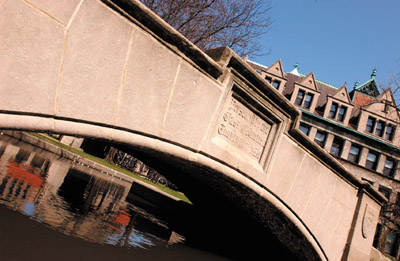 |
|
|||||||||
|
Bridge
over omlsted’s waters Asked to landscape the ten-year-old University, Olmsted called for a plan with simple geometric patterns of walks and drives, broad sweeps of natural landscape rather than individual showpieces, and a general softening of the campus’s Gothic edges. As he wrote in his March 1902 report to Chicago’s trustees, “[T]he comparative simplicity of some of the buildings, not to say the slight suggestion of clumsiness, seems to make it desirable to train vines upon the buidings.”
Olmsted also believed that landscaping should be done in concert with a building’s architects and users, and in designing the Hull Biological Laboratories court he worked with botany professor John W. Coulter to create the water feature, whose borders were planted with water plants and waterside shrubbery while the pond was stocked with exotic flora from the botany department. Members of the Class of 1922 gathered at “their” bridge on the afternoon of the 1923 Reunion’s “Alumni Day,” then marched together in the annual parade—where they won the banner for the largest class showing. —M.R.Y.
|
|
Contact
|


